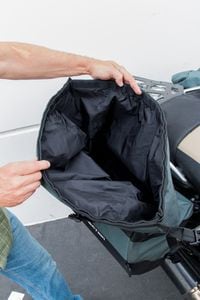WRIST: Marc Cook
MSRP (2014): $12,699
MILES: 13,756
MPG: 41
MODS: SW-Motech/Bags Connection Dakar saddlebags
Update: 8
After sampling the Suzuki accessory hard saddlebags on my long-term V-Strom 1000, and then traveling with the SHAD large-capacity bags, I decided it was time to go a little simpler, a little lighter.
The SW-Motech/Bags Connection Dakar saddlebags fit the bill perfectly. Sold through Twisted Throttle , these bags are clever in myriad ways. First of all, the common problem of large soft saddlebags coming in contact with the bike's bodywork, suspension, exhaust system or other hard parts has been eliminated by bike-specific mounts. These are simply tubular-steel braces that, in the case of the Suzuki, bolt onto the same place the other luggage carriers go. Four bolts per side, just along the rear subframe. SW-M provides spacers that allow you to retain the V-Strom's plastic close-out piece, though, naturally, I used a set of smaller spacers to bring the brackets closer to the bike's centerline.
The bags themselves have lightweight plastic receivers on the back face—incidentally, the bags are symmetrical except for the over flaps, so there’s really no left or right—that slide onto the steel-tube racks from below. A tab clicks home when the bags are fully seated. But it’s not strong enough to carry the load, so each bag has a robust flap backed by hook-and-loop fastener. The idea is that you sling the flaps over the passenger portion of the seat, take up the slack, and have them mate; this puts the load of the luggage on the seat and not onto the side brackets, which are more for lateral placement. It is possible to run the flaps under the aft portion of the saddle to preserve passenger comfort, at least on the V-Strom. I can't speak for other bikes.
In the case of the Suzuki V-Strom 1000, SW-M recommends using a supplied spacer to rotate the exhaust system down slightly to clear the inboard edge of the right bag. I did this while I was still running the stock muffler, and found that the leading edge of the muffler would touch down under fairly aggressive cornering. With the Holeshot Performance slip-on I’m running now, the spacing link is unnecessary.
The bags themselves are made from 1,680-denier nylon and are essentially two layers, an outer shell with stiffening material on the inner, bottom, and outer surfaces, and an inner “drybag” liner. Closure is typical dry bag—pull the two sealing faces together (they’re also mated by hook-and-loop tape), push down to evacuate as much air as you can from the bag, and roll the closure down toward the bag. Plastic buckles on the ends reach down to their mates on the lower edge of bag to finish the process. True, this takes more time than opening and closing a plastic lid on hard luggage, but it’s a solid system and quick enough once you get the hang of it.
Capacity is listed as 32 liters per bag, but they’re flexible enough that you can over-stuff them and gain a bit more if you need it. That flexibility also allows you to cinch them tighter to the bike when they’re less than fully loaded. Win, win.
In use, the Dakar bags are very good. They’re water tight, according to in-use testing and a test with the garden hose, and easy to dismount. So much so that I never did remove the dry bag and leave the shells on the bike at an overnight stop; it’s just so easy to release the crossover flaps, drop the bags off the tubular mounts, and carry them to your destination.
If there’s a downside to the Dakar system it’s price. Including the bike-specific mounts, the set runs $540. Less than hard luggage, sure, but well above a whole host of similar-capacity soft saddlebags. Consider it the cost of the mount system and the heavy-duty construction of the bags themselves, I suppose.
As for the rest of the V-Strom, it continues to chug along, needing almost nothing but an occasional spritz of the chain, premium unleaded in the tank, and, soon, tires. The Avon Distanzias have been on there for 5,100 miles and the rear is getting close to the wear bars. I suspect that the bike will be ready for a new set of skins before the next scheduled maintenance at 14,500 miles.
















/cloudfront-us-east-1.images.arcpublishing.com/octane/G4MG6OUCJNBSHIS2MVVOTPX65E.jpg)
/cloudfront-us-east-1.images.arcpublishing.com/octane/IIGGWFOTOJGB7DB6DGBXCCMTDY.jpg)
/cloudfront-us-east-1.images.arcpublishing.com/octane/QSTCM6AVEZA5JJBUXNIQ3DSOF4.jpg)
/cloudfront-us-east-1.images.arcpublishing.com/octane/U4I7G625B5DMLF2DVIJDFZVV6M.jpg)
/cloudfront-us-east-1.images.arcpublishing.com/octane/B6XD6LS6IVCQPIU6HXDJSM3FHY.jpg)
/cloudfront-us-east-1.images.arcpublishing.com/octane/ICL63FEDDRDTTMINYICCEYGMDA.jpg)
/cloudfront-us-east-1.images.arcpublishing.com/octane/FCGZHQXRBZFLBAPC5SDIQLVF4I.jpg)
/cloudfront-us-east-1.images.arcpublishing.com/octane/WNOB6LDOIFFHJKPSVIWDYUGOPM.jpg)

/cloudfront-us-east-1.images.arcpublishing.com/octane/X33NU3E525ECRHXLNUJN2FTRKI.jpg)
/cloudfront-us-east-1.images.arcpublishing.com/octane/6KKT5NNL2JAVBOXMZYS5ZO76YA.jpg)
/cloudfront-us-east-1.images.arcpublishing.com/octane/J5RKG5O455GMPGQRF2OG6LRT7A.jpg)
/cloudfront-us-east-1.images.arcpublishing.com/octane/GX2CIZKQVRH2TATDM26KFG2DAE.jpg)
/cloudfront-us-east-1.images.arcpublishing.com/octane/ZWIDYSAKQZHD5BHREMQILXJCGM.jpg)
/cloudfront-us-east-1.images.arcpublishing.com/octane/CYUHJZCTSJCH3MRAQEIKXK7SCQ.jpg)
/cloudfront-us-east-1.images.arcpublishing.com/octane/LKOFINY56FCXJCANJ5M7ZDQUBY.jpg)
/cloudfront-us-east-1.images.arcpublishing.com/octane/4NBPDACMWJH63JQYJVK3QRBDZI.jpg)
/cloudfront-us-east-1.images.arcpublishing.com/octane/KKHQHRR3FJGX7H2IPU6RALMWG4.jpg)

/cloudfront-us-east-1.images.arcpublishing.com/octane/5IOFS5JAE5FOXMNA23ZRAVVYUU.jpg)
/cloudfront-us-east-1.images.arcpublishing.com/octane/CGXQ3O2VVJF7PGTYR3QICTLDLM.jpg)

/cloudfront-us-east-1.images.arcpublishing.com/octane/OQVCJOABCFC5NBEF2KIGRCV3XA.jpg)
/cloudfront-us-east-1.images.arcpublishing.com/octane/OPVQ7R4EFNCLRDPSQT4FBZCS2A.jpg)